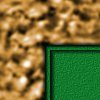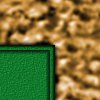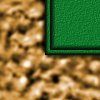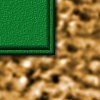
WHAT ARE FROGS ? Frogs are members of the zoological class called Amphibia. This actually includes frogs and toads.
When we think of frogs, we generally picture what are called true frogs, who are members of the family Ranidae, which contains more than 400 species! Frogs aid humans in many ways. They control insect pests in wooded areas, farms, and gardens, and several species have been introduced to various parts of the world as a defense against undesirable insects.
APPEARANCE : Frogs have the characteristics of: two bulging eyes; strong, long, webbed hind feet that are adapted for leaping and swimming; and smooth or slimy skin (generally, frogs tend to like moister environments than toads). Tree frogs have sucker-like adhesive disks, or suction pads, which aid in the climbing of vertical surfaces, on the tips of their fingers and toes. Aquatic Frogs like the African Dwarf Frog , or the African Clawed Frog, have webbing between their toes that aids in swimming. Frogs that burrow to keep moist in the heat have stubby clawlike fingers that are adapted to digging.
The following are pictures of my two African Dwarf Frogs. The first one I got over 10 years ago. That one matured and started singing for a mate, and since it was unlikely one would respond, we got another one for the tank. They get along great, but no more singing... They have mated, and laid eggs, but none have matured. The following pictures are of the two frogs and some of the eggs that they have had.





WHAT THEY EAT : Frogs principally eat insects, worms, spiders, and centipedes. Aquatic frogs sometimes eat other frogs, tadpoles, and small fish. Larger frogs eat objects as large as mice or small snakes. Tadpoles mostly feed on algae and other vegetation, although a few are carnivorous and may even feed on their siblings!
WHERE THEY LIVE : Frogs are native to most parts of the world, except Antarctica, the driest deserts, and many oceanic islands, but the greatest variety are found in moist, tropical areas. Frogs live in a variety of habitats, but most prefer moist regions. Tree frogs are adapted for tree living; other frogs are permanently aquatic; still others spend most of their lives in underground burrows, coming up only to feed or breed.
 TADPOLE TIME : 1) Frogs tend to lay eggs in clusters. Most eggs are laid in calm or static waters. TADPOLE TIME : 1) Frogs tend to lay eggs in clusters. Most eggs are laid in calm or static waters.
2) After being fertilized, in about 6-21 days, the eggs will hatch. The tadpole at this point consists mostly of poorly developed gills, a mouth, and a tail. It's really fragile at this point. It will usually will stick itself to floating weeds or grasses in the water using little sticky organs between its mouth and belly area.
3) Then, 7 to 10 days after the tadpole has hatched, it will begin to swim around and feed on algae.
4) After about 4 weeks, the gills start getting grown over by skin, until they eventually disappear. The tadpoles develope tiny teeth which help them grate food turning it into soup-like particles. Tadpoles have long coiled guts that help them digest as much nutrients from their meager diets as possible. By the fourth week, tadpoles can actually be fairly social creatures. Some even interact and school like fish!
5) After about 6 to 9 weeks, little tiny legs start to sprout. The head becomes more distinct and the body elongates. By now the diet may grow to include larger items like dead insects and even plants. The arms will begin to bulge where they will eventually pop out, elbow first.
6) After about 9 weeks, the tadpole looks more like a teeny frog with a really long tail. It is now well on its way to being almost fullgrown!
7) By 12 weeks, the tadpole has only a small tail stub and looks like a miniature version of the adult frog. Soon, it will leave the water, only to return again to lay more eggs and start the process all over again!
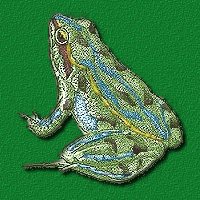 SPECIES FOUND IN THIS AREA : Found in the southern Appalachians are: the Common Gray Treefrog, which consists of 2 species that are indistinguishable in the field; Wood Frog, the only North American frog that can be found north of the Artic Circle; Pickerel Frog, a nocturnal frog whose secretions will kill other frogs kept with them; Spring Peeper, whose chorus is among the first signs of spring; Green Frog, which can be green or brown with ridges along its back. The following are pictures of locally found frogs: 1st Row - Grey Treefrog and Spring Peeper. 2nd Row - Wood Frog SPECIES FOUND IN THIS AREA : Found in the southern Appalachians are: the Common Gray Treefrog, which consists of 2 species that are indistinguishable in the field; Wood Frog, the only North American frog that can be found north of the Artic Circle; Pickerel Frog, a nocturnal frog whose secretions will kill other frogs kept with them; Spring Peeper, whose chorus is among the first signs of spring; Green Frog, which can be green or brown with ridges along its back. The following are pictures of locally found frogs: 1st Row - Grey Treefrog and Spring Peeper. 2nd Row - Wood Frog








VERY IMPORTANT FROG NEWS : Sharp declines of frogs and salamanders in many parts of the country has not happened in Western North Carolina, as reported by researchers at a conference in Washington, DC. Because amphibians live on both land and water, researchers use them to gauge the health of the habitat. A decline in population or changes in the physiology of amphibians usually point to an unhealthy environment. Ken Dodd, of the U.S. Geological Survey, reported that in the Southeast USA, they did not find the serious declines and malformations that have been found in other parts of the country. But, long term health of the region's remote areas no longer guarantee a healthily amphibian population. The researchers report that amphibians will disappear when wetlands and swamps are drained, but more subtle threats carried by wind and rain, such as acid rain, can be carried to these remote areas. In the Southern Appalachians, acid rain from air pollution is a greater concern than pesticides. It is known that amphibians are extremely sensitive to acidity levels of soils. This is something that must be carefully watched as acid rain can be carried from far away.
CLASSIFICATION : Frogs are classified in the phylum -Chordata, subphylum -Vertebrata, class -Amphibia, order -Anura. True frogs make up the family Ranidae. The Wood Frog is classified as Rana sylvatica; the Pickerel Frog is classified as Rana palustris; the Green Frog as Rana clamitans; the Spring Peeper is Hyla crucifer; the Common Gray Treefrog is either Hyla versicolor or the Cope's Gray Treefrog Hyla chrysoscelis.

References and Links
- "Reptiles & Amphibians of the Smokies" by Stephen G. Tilley and James E. Huheey
- "Discovering Amphibians" by John Himmelman
- "Eastern Foresst" by Ann and Myron Sutton
- "North American Wildlife" published by Reader's Digest
- "The Encyclopedia of Amphibians" by Robert Hofrichter
- African Dwarf Frog Infomation at Frogland
- Frogland - A source for all things froggie and toady. Includes indepth species caresheets.
- Livingunderworld.org
To find out more about amphibians just find and click
on the frogs in the coconut tree at the top of this page!
Or try these links:
Frogs | Toads | Salamanders and Newts | Caecilians
Click here to return to Caribbean Amphibian
Home
Site Map
Email at: dh @ naturehaven.com
(Take out the spaces and this email address will work!)
Ribbit! Ribbit!
|
